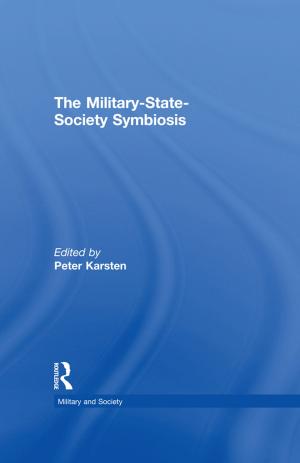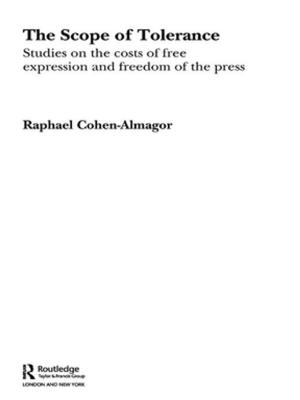| Author: | ISBN: | 9781317912408 | |
| Publisher: | Taylor and Francis | Publication: | April 24, 2015 |
| Imprint: | Routledge | Language: | English |
| Author: | |
| ISBN: | 9781317912408 |
| Publisher: | Taylor and Francis |
| Publication: | April 24, 2015 |
| Imprint: | Routledge |
| Language: | English |
Security and Conflict in East Asia provides a timely and comprehensive analysis of the sources and implications of conflict on the Korean peninsula and in the People’s Republic of China and Japan, the three biggest economies in the world. This analysis provides the building blocks for effective solutions to manage these tensions more effectively, and is a vital resource to those seeking a clearer understanding of conflict in the most pivotal region in the world. In the context of increasingly tense China-US strategic rivalry, the ever-present potential for conflict on the Korean peninsula and over Taiwan, the absence of effective regional institutions and regimes, the emerging arms race in the region, the rise in nationalism and the absence of crisis management mechanisms, there are many good reasons why the high potential exists for miscalculation and misperception sparking a regional conflict. Given the presence of nuclear-armed powers in East Asia, namely, China, North Korea and the USA, it is also possible that any regional conflict could escalate into a nuclear conflict involving the world’s three largest economies: the USA, China and Japan. The security of, and any conflict in, East Asia thus has tremendous implications for global security.
The Handbook is divided into four parts. The introductory section includes chapters which set the context, explain the history of international relations in East Asia and examine the phenomenon of regional arms race. The second section is made up of a series of chapters focusing on China, examining China’s military modernization, its relationship with the USA and the various territorial disputes in which it has been involved. The third section focuses on Japan and North and South Korea, looking at the security challenges facing Japan and the Korean peninsula. A concluding section examines the future role of China and the USA in East Asia, as well as the prospects for managing security in the region. The contributing authors are all experts in their respective fields, and all share an abiding concern over developments in East Asia. Their contributions aim to assist in a better understanding of the issues, to suggest possible solutions, and draw attention to the need for diplomacy, confidence-building measures, crisis management mechanisms and other measures to prevent conflict.
This volume will be of use to government institutions involved in foreign policy, intelligence and defence, reference libraries, universities, research institutes, and non-governmental organisations. It will also appeal to analysts, researchers, journalists, policy advisers, students, academics and the general reader. Scholarly analysis is yet to catch up and currently there are no other comprehensive works examining conflict in East Asia in the context of the current tensions.
Security and Conflict in East Asia provides a timely and comprehensive analysis of the sources and implications of conflict on the Korean peninsula and in the People’s Republic of China and Japan, the three biggest economies in the world. This analysis provides the building blocks for effective solutions to manage these tensions more effectively, and is a vital resource to those seeking a clearer understanding of conflict in the most pivotal region in the world. In the context of increasingly tense China-US strategic rivalry, the ever-present potential for conflict on the Korean peninsula and over Taiwan, the absence of effective regional institutions and regimes, the emerging arms race in the region, the rise in nationalism and the absence of crisis management mechanisms, there are many good reasons why the high potential exists for miscalculation and misperception sparking a regional conflict. Given the presence of nuclear-armed powers in East Asia, namely, China, North Korea and the USA, it is also possible that any regional conflict could escalate into a nuclear conflict involving the world’s three largest economies: the USA, China and Japan. The security of, and any conflict in, East Asia thus has tremendous implications for global security.
The Handbook is divided into four parts. The introductory section includes chapters which set the context, explain the history of international relations in East Asia and examine the phenomenon of regional arms race. The second section is made up of a series of chapters focusing on China, examining China’s military modernization, its relationship with the USA and the various territorial disputes in which it has been involved. The third section focuses on Japan and North and South Korea, looking at the security challenges facing Japan and the Korean peninsula. A concluding section examines the future role of China and the USA in East Asia, as well as the prospects for managing security in the region. The contributing authors are all experts in their respective fields, and all share an abiding concern over developments in East Asia. Their contributions aim to assist in a better understanding of the issues, to suggest possible solutions, and draw attention to the need for diplomacy, confidence-building measures, crisis management mechanisms and other measures to prevent conflict.
This volume will be of use to government institutions involved in foreign policy, intelligence and defence, reference libraries, universities, research institutes, and non-governmental organisations. It will also appeal to analysts, researchers, journalists, policy advisers, students, academics and the general reader. Scholarly analysis is yet to catch up and currently there are no other comprehensive works examining conflict in East Asia in the context of the current tensions.















